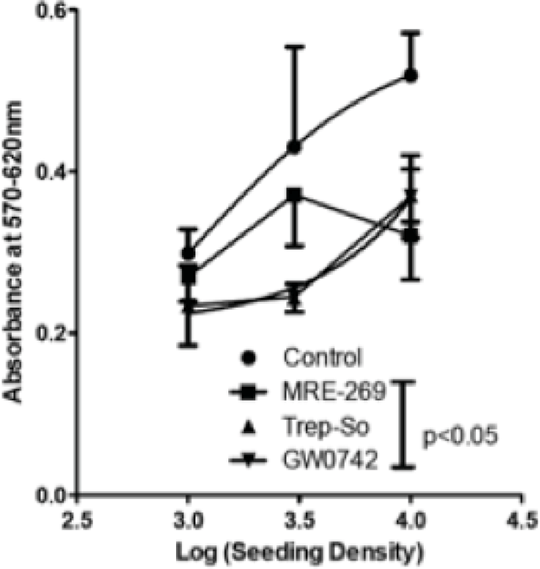Print version
Search Pub Med
Prostacyclin drugs and the PPARβ agonists GW0742 limit proliferation of endothelial cells grown out from human blood Pulmonary arterial hypertension (PAH) is a rare but severe disease. In some patients, highly proliferative clonal endothelial cell populations form lesions, the so-called, plexiform lesions. These contribute to vascular remodelling in PAH. Endothelial cells can be grown out of blood progenitor cells; these are commonly referred to as blood outgrowth endothelial cells (BOECs), which are a potentially valuable and useful model to study vascular dysfunction in cardiorespiratory disease. BOECs are highly proliferative cells, which grow out of colonies over the course of 6-20 days in culture. In some respects these cells have parallels with those forming plexiform lesions in the vessels of patients with PAH. Current, prostacyclin drugs act as agonists of either cell surface prostacyclin receptor (IP) and/or the cytosolic prostacyclin receptor, peroxisome proliferator activated-receptor-Beta (PPARβ). They are important therapies for the treatment of PAH, however their effect on highly proliferative endothelial cell types is not known. The purpose of this study was to compare the effects of prostacyclin drugs on BOEC proliferation in vitro. We examined the effects of (i) Trepostinil sodium, which is currently used therapeutically to treat PAH and works on cell surface prostacyclin IP receptors as well as on cytosolic prostacyclin PPARβ receptors(1, 2), (ii) MRE-269, which is the active metabolite of a new therapeutic for PAH, Selexipag, which activates IP receptors selectively and (iii) GW0742, not currently used as a PAH drug, which activates PPARβ receptors selectively. BOECs were grown from (n=4) healthy donors and stimulated to proliferate using techniques described previously (3). Cells were plated at a range of seeding densities (1, 3, 10 x 103) and treated with MRE-269 (1μM), Trepostinil sodium (1μM), GW0742 (10μM) or vehicle (0.1% DMSO) for 24 hours. Proliferation was measured using the AlarmarBlue® method. All three drugs tested inhibited proliferation of BOECs. 
Figure 1: Effect of MRE-269, Trepostinil Sodium (Trep-So) or GW0742 for 24 hours on proliferation of BOECs. Data is mean ± S.E.M. for cells of (n=4) donors. Data was analysed using a two-way ANOVA (p<0.05 for each drug compared to control). These observations suggest that prostacyclin related drugs might offer some protection against division of highly proliferative endothelial cells, e.g. BOECs. Our findings that the PPARβ agonist was particularly effective in this regard adds weight to the idea that drugs acting on this pathway could be useful in the treatment of PAH (4). How this relates to effects of these drugs on PAH BOECs or plexiform ECs remains the subject of investigation. 1. Ali FY et al, Am J Respir Cell Mol Biol 34:242, 2006 2. Ali FY et al, FASEB J 20:326, 2006 3. Starke RD et al, Blood 121:2773, 2013 4. Harrington LS et al, PLoS One 5:e9526, 2010 |


